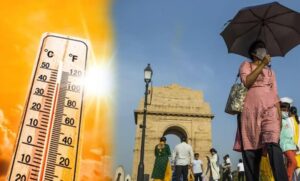 Delhi is experiencing dangerously rising temperatures, with last year’s historic 52.3°C reading at Mungeshpur standing as the city’s highest ever. As the summer of 2025 unfolds, the heat continues to grip the capital with intense and prolonged heatwaves.
Delhi is experiencing dangerously rising temperatures, with last year’s historic 52.3°C reading at Mungeshpur standing as the city’s highest ever. As the summer of 2025 unfolds, the heat continues to grip the capital with intense and prolonged heatwaves.
In May 2024, the Mungeshpur weather station recorded a scorching 52.3°C the highest temperature ever noted in Delhi’s history. However, this reading was flagged by the India Meteorological Department (IMD) as an “outlier.” While some experts suspected a possible sensor error or unusual local factors influencing the data, the reading reflected the growing severity of the city’s heat conditions. At the same time, Delhi’s main observatory at Safdarjung reported a high of 46.8°C a more reliable indicator of the city’s extreme heat that day.
This alarming heat trend has continued into 2025. On June 9, temperatures in Aya Nagar touched 45.3°C, the highest mark of the recent heatwave, while other parts like Palam and Ridge also recorded temperatures close to 44-45°C. By June 11, Aya Nagar saw an even hotter day, with the mercury rising to 45.5°C and the heat index the “feels-like” temperature considering humidity spiking to 47.7°C.
On June 12, Delhi’s heatwave intensified further. The city recorded a “feels-like” temperature of 51.9°C, driven by a dangerous mix of high heat and humidity. The IMD issued a red alert, warning of extreme heat conditions likely to persist for the following days.
For June 13, the IMD forecasted a maximum temperature of 41°C and a minimum of 32°C, with the city expected to remain under severe heatwave conditions.
Delhi’s extreme temperatures have triggered multiple challenges. The city hit a record electricity demand of 8,302 megawatts during the 2024 heatwave, highlighting the strain on power supply. Water shortages have also worsened, prompting authorities to enforce penalties for water wastage to manage the crisis.
These prolonged heatwaves carry serious health risks, especially for the elderly, children, and those with pre-existing illnesses. Medical experts have warned of rising cases of heatstroke, dehydration, and heat-related deaths if precautionary measures are not taken.
Despite debates about the accuracy of the 52.3°C record, there is no doubt that Delhi’s summers are becoming hotter, longer, and more dangerous. The IMD and climate experts stress the urgent need for climate resilience measures including better urban planning, green infrastructure, and public awareness to reduce the growing heat burden on India’s capital.
As climate change accelerates, Delhi’s record-breaking heat serves as a stark reminder of the challenges the city and its people will face in the years ahead.
Editor: Vaishali Verma
